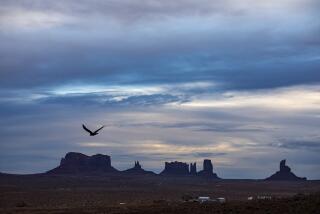Guided Along a River
- Share via
TAHOLAH, Wash. — The old wooden boat, which still seeps water despite all the caulk, may have been borrowed from a relative. Your native American guide might be a tribal elder, or a white man adopted by the tribe in his youth. Your leader could sport tinted aviator glasses and double-knit shirt, or Timex watch, leather huaraches and blue socks.
On the beautiful, meandering Quinault River in western Washington each guide, each boat, each mini-adventure is as distinctive as the man in charge.
A black billed cap with tribal logo clings to Mike Mail’s dark hair. Mail offers 1 1/2-hour scenic river trips, bird-watching outings to nearby Point Grenville, and daylong excursions.
At the weedy river bank there are no ticket booths, no waits in line, no concession stands. A sea gull lights on a wooden boat as Mail fastens a motor onto the 1920 vintage cedar canoe. While the mist still hovers above the water, three cormorants take flight from a mossy boulder, and fly out toward the sea.
On an eight-mile trip upstream, the slim, blue craft glides past gray stone cliffs and murky forests hung with moss. Eyelids squint against the bright, rippling surface of the water and the brisk rush of air.
Cottonwood leaves flutter and twinkle. Even as early as July the legendary Changer has brushed the vine maple leaves with coppery red.
Despite the accidental loss of an eye, Mail can spot a yearling eagle at 100 yards and see a blueback salmon underwater in the silt. The water laps gently against the rock-studded bank, where lacy ferns look radiant in the sun.
Private Grounds
At times the boat slips over synthetic lines and bobbers that hold the Indians’ gill nets; you cruise by festive pink and green streamers that mark private family fishing grounds.
For years, in-the-know sportsmen have booked Quinault River guides through mutual friends. Or lacking connections, a would-be adventurer might stake out a chair in the tribal-run cafe, to catch a guide at breakfast.
Recently, tribal leaders decided to license guides, to make the service available through the tribal administration office. Not that this will change things much in Taholah, where the guides are known to rest as hard as they work.
In the unofficial capital village of the Quinault Nation, mottled dogs guard boats and pickup trucks beside the cedar-shingled houses, locked in a grid of unmarked streets beside the water.
Early in the morning the tables in the cafe fill with assorted guides, loggers and tribal administration personnel. Over fried eggs and hash browns, the conversation flows like the coffee brought in steaming from big urns. And as it has for centuries, talk centers on the forests and the fishing.
A dark-haired tribal official mentions that the river yields 26,000 steelhead a year. There are two hatcheries on the reservation and a large commercial fishing plant; a computerized system monitors each day’s catch.
“The Quinault is probably the best-managed river in North America,” the official claims.
In a far corner one man mumbles something, the others laugh. The chairs scrape, and some men leave.
A sandy-haired logger looks up from his plate and states: “The Indians have always worked along with Mother Nature.”
Veteran Guide
Across the table a white-haired guide with brows as dark and tangled as berry bushes leans back in his chair. Larry Bradley, known to all as “Bear,” has been guiding river trips for 15 years.
“Not everyone who goes out on the river wants to fish,” says Bradley. On a one- or two-day river outing, some guests work at catching trout. Others would rather sit back idly, watching hawks circle the tops of giant spruce.
An ideal river guide plays many roles: tour manager, naturalist, fly-casting coach, storyteller . . . and shrink. Six guides work full-time guiding river trips, six more go out part-time.
Tribal policy allows non-Quinaults to fish only when accompanied by a tribal member.
Mike Mail’s father-in-law, Francis Rosander, has been leading Quinault River trips since 1953. Rosander, a quiet, well-organized man who carries business cards for guests to keep, knows the river the way a car driver does when he slows for that peculiar hump in the driveway.
Each rock and riffle triggers Rosander’s memory. Once the guide caught his canoe pole in that crack above the water’s edge and fell overboard. Another time he took the canoe safely through the narrows between those boulders while carrying 500 added pounds of fresh-killed elk.
When the guide cuts the motor, the boat turns slowly like a floating leaf. A raccoon stands near the bank in shallow water, gazing at the passing boat.
Even with a beginner, Rosander has patience, even with a first-time fisherperson who forgets to lift her finger to release the line when she casts.
Eager to reveal the trout’s favorite hiding places, the guide points to eddies beside swift-flowing, blue-green water. Slim, silver smolts jump teasingly from the moving stream.
Catch of the Day
If pressed for truth, Rosander will even admit making the catch of the day. Not the 23-inch “stickfish” that the client snagged, but the glossy, four-inch trout that was promptly thrown back into the water.
An early Quinault legend tells of a rare famine. When the people had no fish, the eagle and a boy made fish plentiful in the river again. In another tale, the wise eagle chooses not to make life too easy for the people.
It’s never easy. The determined adventurer must still rise early to see a deer . . . to catch a slippery river guide at breakfast . . . to get the most the river will give.
Step into the boat and you’re a grown-up, paying for the kind of well-earned day that can’t ever be bought. Step out of the boat and you’ll feel like a kid.
-- -- --
The Quinaults manage tribal fishing waters from an early treaty with the U.S. government, allowing non-members half the harvestable catch.
Taholah village is marked by a roadside sign. Rental cars available at SeaTac airport.
Resorts: Ocean Crest Resort, Moclips, Wash. 98562, phone (206) 276-4465. Hi-Tide Ocean Beach Resort, Moclips, Wash. 98562, phone (206) 276-4142.
Moclips Motel, Moclips, Wash. 98562, phone (206) 276-4228.
Eating at Ocean Crest Dinner House, Moclips, Wash.; The Lighthouse, Pacific Beach, Wash. Additional accommodations, restaurants and RV parks south of Moclips along the ocean.
All-day river excursion, $110 per person a day. Hour-and-a-half scenic trips, $10 per person. Overnight camping by special arrangement with guide.
Guest brings fishing gear, rubber boots, warm and rainproof clothing, lunch, thermos, snacks, camera.
Contacts: Mike Mail, Quinault sport fishing chairman, phone (206) 276-8211. Guide Francis Rosander, phone (206) 276-4315. Guide Phillip Martin, Quinault hatchery, phone (206) 288-2684. Additional information, Quinault Tribal Administration Office, P.O. Box 189, Taholah, Wash. 98587, phone (206) 276-8211.
More to Read
Sign up for The Wild
We’ll help you find the best places to hike, bike and run, as well as the perfect silent spots for meditation and yoga.
You may occasionally receive promotional content from the Los Angeles Times.






